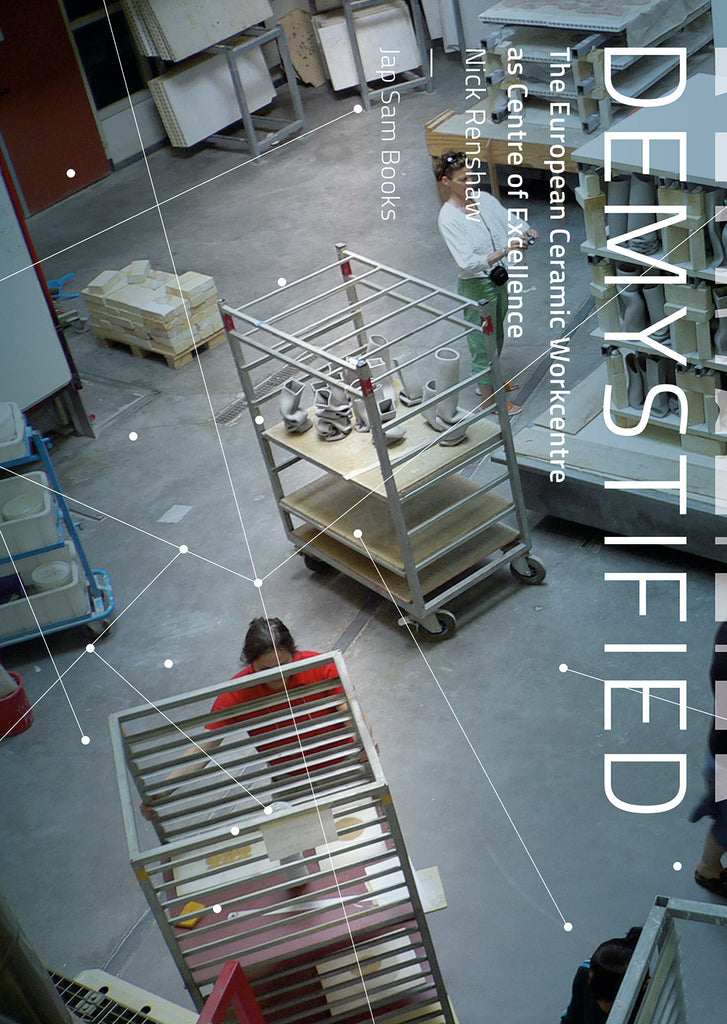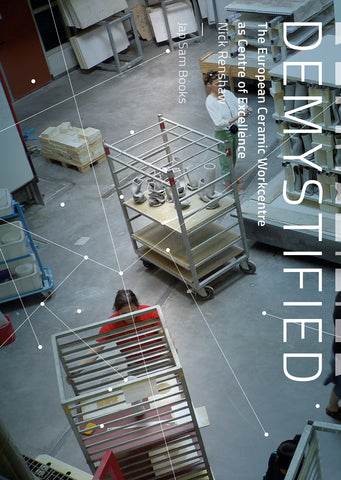Your cart is currently empty!
Demystified
+++The European Ceramic Workcentre as Centre of Excellence+++
+++Nick Renshaw+++
978-94-90322-71-7
Montse Hernández i Sala
300
17 x 24 cm
Softcover
Engelstalig
Verschijningsdatum: maart 2017
Deze publicatie wordt mede mogelijk gemaakt door het Stimuleringsfonds Creatieve Industrie, Stichting Van Achterbergh Domhof, het EKWC.
The European Ceramic Workcentre (EKWC) is regarded widely as a world-leading organisation. A world-leader through its work as artist in residence centre where practice using the ceramic material is hosted, and a world-leader through its work as institution where the innovative use of this material in all areas of design and the visual arts is promoted. Though carrying an intrinsically global reach it is an institution rooted deeply in the very unique cultural history of the Netherlands, a fundamental factor in any discussion of its behaviour and one that is emphasised appropriately in this study.
The high regard with which the EKWC is appreciated is recognised throughout the wider visual arts, across borders as well as much further afield. By the thousands of individuals who have either already passed through its doors as temporary, invited or guest residents or by the many who remain eager to do so in future. By a wide range of related organisations, either other residence centres, art academies, individual ceramic studios, conference administrations, biennials or symposia that see the EKWC as the role model on which to base their own practice. And by theoreticians, critics, journalists and politicians who have each come to recognise the leading position of the EKWC and its lasting theoretical impact in countless articles, journals, reports, catalogues and all manner of other published material.
That the centre may be regarded so highly within just one of these groups would make it worthy of further attention. That it is acknowledged equally significantly across multiple fields makes it clearly a special case indeed. In keeping with an organisation so highly regarded an extensive degree of documentation exists which recognises the work undertaken by this centre. What though is apparent throughout this recognition is that it has remained by and large precisely that. A recognition of the Centre's standing rather than the offering of a clear understanding into the reasoning behind its success.
Demystified: The European Ceramic Workcentre as Centre of Excellence deciphers for the first time the specific and fundamental reasoning for the successes behind this world leader. It describes the complex system of operation that exists throughout the entire organisation, a system that has matured and been refined over the course of the previous four decades. It explains how such an ideal working environment has developed, why this is unique to the EKWC, and why such excellence in practice is difficult to find in other related organisations around the world.
Rather than focus attention on the already documented, innumerable results and artefacts of countless collaborations and working partnerships over previous decades, this survey describes with text and a comprehensive image base how it is that such results have been achieved. It explains how the nature of this work is influenced by prevailing circumstances and decision-making, be they of a logistical, directorial or theoretical nature. It is a demystification of previously unidentified interrelationships which explains how the interactive nature of an organisation such as the EKWC impacts on those working within it, and subsequently how it influences a much wider community outside.
This study can be seen as important and of interest to a potentially wide and eclectic audience both within and outside the visual arts, ceramic and design fields. To artists, ceramists, designers as well as other individuals in the art world who are able to understand the practical relevance for application to their own activity. To those either already involved in or who wish to take part in the artist in residence field. To other organisations across the wider visual arts, design and ceramic fields who could use the identified system in place at the EKWC as basis for their own future development. To universities and art and design academies who could apply aspects of the Centre's successful operation to their own institutions. And to potentially countless organisations outside the visual arts whose practice may at first seem unrelated but who could use the excellence of practice supported by the EKWC as a model from which to develop similar innovative behavior within their own organisations.
Over de auteur
Visual artist and researcher Nick Renshaw (PhD) maintains studios in Amsterdam, the Netherlands and in Xiamen, southern China. His doctoral research into the field of international ceramic art residencies, entitled 'The European Ceramic Workcentre as Successful Model: Evaluating the Standing, Nature and Potential for Practice in Ceramic Art Residencies', was an Arts and Humanities Research Council (AHRC) supported collaboration with the University of Sunderland (UoS) in the United Kingdom. This research was borne from Renshaw's extensive work with institutions working in the field of ceramic and art residence activity over the previous two decades, particularly so with regard to the European Ceramic Workcentre in the Netherlands.
His previous studies include an MA through the Sandberg Instituut in Amsterdam, the Netherlands, during which time he also studied at Pratt Institute in Brooklyn, the United States. His undergraduate studies included a BA with Cum Laude from the Gerrit Rietveld Academie in Amsterdam, the Netherlands, as well as a BA from Manchester Polytechnic in Manchester, the United Kingdom. While at Manchester he also studied at the world-renowned New York State College of Ceramics and Glass at Alfred University in the United States.
Renshaw's sculptures and works as visual artist have been exhibited, collected and commissioned worldwide through independent galleries, museums and a range of public spaces. Recent presentations and commissions include: Clay! One Hundred Years Ceramics at the Gerrit Rietveld Academie at the Gemeentemuseum Den Haag; Fifteen Year Anniversary exhibition at the Chinese European Art Center (CEAC), Xiamen, P.R China; Six McKnight Artists at the Northern Clay Center, Minneapolis, USA; Other Origins at Galerie De Witte Voet in Amsterdam; Rolling Snowball III at the Redtory Art + Design Factory in Guangzhou, P.R China; and Sitting/Standing for the new city hall of Ouderkerk aan de Amstel in the Netherlands.
Renshaw's visual arts practice draws on myriad references, both historical and contemporary. His sculptures are reminiscent of the archaeological finds, pre-historic images, and ancient iconography of his upbringing in the historic city of York in England, as well as being depictions and representations of imagery referencing issues of current cultural concern.
He is currently teaching at Xiamen University in the south of China, and part of a new body of works entitled Tong An can currently be seen at the British Centre in the IFC Tower in Guangzhou and was recently presented in the exhibition Boundless Material at Kui Yuan Gallery, also in Guangzhou.
The European Ceramic Workcentre as Centre of Excellence
€33.00
Demystified
The European Ceramic Workcentre as Centre of Excellence
€33.00
Kunst / Vormgeving / Theorie
978-94-90322-71-7
Montse Hernández i Sala
300
17 x 24 cm
Softcover
Engelstalig
Verschijningsdatum: maart 2017
Deze publicatie wordt mede mogelijk gemaakt door het Stimuleringsfonds Creatieve Industrie, Stichting Van Achterbergh Domhof, het EKWC.
The European Ceramic Workcentre (EKWC) is regarded widely as a world-leading organisation. A world-leader through its work as artist in residence centre where practice using the ceramic material is hosted, and a world-leader through its work as institution where the innovative use of this material in all areas of design and the visual arts is promoted. Though carrying an intrinsically global reach it is an institution rooted deeply in the very unique cultural history of the Netherlands, a fundamental factor in any discussion of its behaviour and one that is emphasised appropriately in this study.
The high regard with which the EKWC is appreciated is recognised throughout the wider visual arts, across borders as well as much further afield. By the thousands of individuals who have either already passed through its doors as temporary, invited or guest residents or by the many who remain eager to do so in future. By a wide range of related organisations, either other residence centres, art academies, individual ceramic studios, conference administrations, biennials or symposia that see the EKWC as the role model on which to base their own practice. And by theoreticians, critics, journalists and politicians who have each come to recognise the leading position of the EKWC and its lasting theoretical impact in countless articles, journals, reports, catalogues and all manner of other published material.
That the centre may be regarded so highly within just one of these groups would make it worthy of further attention. That it is acknowledged equally significantly across multiple fields makes it clearly a special case indeed. In keeping with an organisation so highly regarded an extensive degree of documentation exists which recognises the work undertaken by this centre. What though is apparent throughout this recognition is that it has remained by and large precisely that. A recognition of the Centre's standing rather than the offering of a clear understanding into the reasoning behind its success.
Demystified: The European Ceramic Workcentre as Centre of Excellence deciphers for the first time the specific and fundamental reasoning for the successes behind this world leader. It describes the complex system of operation that exists throughout the entire organisation, a system that has matured and been refined over the course of the previous four decades. It explains how such an ideal working environment has developed, why this is unique to the EKWC, and why such excellence in practice is difficult to find in other related organisations around the world.
Rather than focus attention on the already documented, innumerable results and artefacts of countless collaborations and working partnerships over previous decades, this survey describes with text and a comprehensive image base how it is that such results have been achieved. It explains how the nature of this work is influenced by prevailing circumstances and decision-making, be they of a logistical, directorial or theoretical nature. It is a demystification of previously unidentified interrelationships which explains how the interactive nature of an organisation such as the EKWC impacts on those working within it, and subsequently how it influences a much wider community outside.
This study can be seen as important and of interest to a potentially wide and eclectic audience both within and outside the visual arts, ceramic and design fields. To artists, ceramists, designers as well as other individuals in the art world who are able to understand the practical relevance for application to their own activity. To those either already involved in or who wish to take part in the artist in residence field. To other organisations across the wider visual arts, design and ceramic fields who could use the identified system in place at the EKWC as basis for their own future development. To universities and art and design academies who could apply aspects of the Centre's successful operation to their own institutions. And to potentially countless organisations outside the visual arts whose practice may at first seem unrelated but who could use the excellence of practice supported by the EKWC as a model from which to develop similar innovative behavior within their own organisations.
Over de auteur
Visual artist and researcher Nick Renshaw (PhD) maintains studios in Amsterdam, the Netherlands and in Xiamen, southern China. His doctoral research into the field of international ceramic art residencies, entitled 'The European Ceramic Workcentre as Successful Model: Evaluating the Standing, Nature and Potential for Practice in Ceramic Art Residencies', was an Arts and Humanities Research Council (AHRC) supported collaboration with the University of Sunderland (UoS) in the United Kingdom. This research was borne from Renshaw's extensive work with institutions working in the field of ceramic and art residence activity over the previous two decades, particularly so with regard to the European Ceramic Workcentre in the Netherlands.
His previous studies include an MA through the Sandberg Instituut in Amsterdam, the Netherlands, during which time he also studied at Pratt Institute in Brooklyn, the United States. His undergraduate studies included a BA with Cum Laude from the Gerrit Rietveld Academie in Amsterdam, the Netherlands, as well as a BA from Manchester Polytechnic in Manchester, the United Kingdom. While at Manchester he also studied at the world-renowned New York State College of Ceramics and Glass at Alfred University in the United States.
Renshaw's sculptures and works as visual artist have been exhibited, collected and commissioned worldwide through independent galleries, museums and a range of public spaces. Recent presentations and commissions include: Clay! One Hundred Years Ceramics at the Gerrit Rietveld Academie at the Gemeentemuseum Den Haag; Fifteen Year Anniversary exhibition at the Chinese European Art Center (CEAC), Xiamen, P.R China; Six McKnight Artists at the Northern Clay Center, Minneapolis, USA; Other Origins at Galerie De Witte Voet in Amsterdam; Rolling Snowball III at the Redtory Art + Design Factory in Guangzhou, P.R China; and Sitting/Standing for the new city hall of Ouderkerk aan de Amstel in the Netherlands.
Renshaw's visual arts practice draws on myriad references, both historical and contemporary. His sculptures are reminiscent of the archaeological finds, pre-historic images, and ancient iconography of his upbringing in the historic city of York in England, as well as being depictions and representations of imagery referencing issues of current cultural concern.
He is currently teaching at Xiamen University in the south of China, and part of a new body of works entitled Tong An can currently be seen at the British Centre in the IFC Tower in Guangzhou and was recently presented in the exhibition Boundless Material at Kui Yuan Gallery, also in Guangzhou.

















